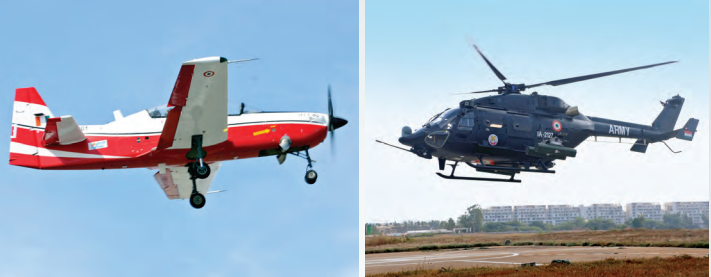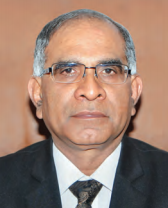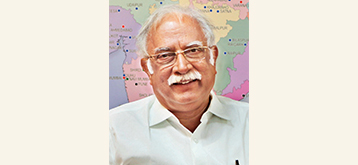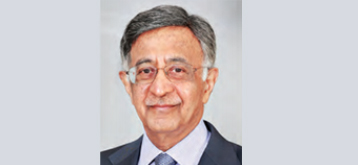T Suvarna Raju
Biz@India
June 2017
With a slew of indigenous products and programmes, HAL has already been contributing to the governments’ ‘Make in India’ initiative, says Raju.
Hindustan Aeronautics Limited (HAL) is the premier organisation amongst the Defence Public Sector Undertakings (DPSUs) in India. Its chairman and managing director, T Suvarna Raju talks to Biz@India about the challenges of heading an institution that’s at the forefront of developing India’s indigenous aerospace and defence industry. Along with that he also discusses their current initiatives and future plans.
It has been two years since you have been heading HAL. What have been the challenges so far? How was the company’s performance in the last fiscal year and what are your projections for the next year?
It is a matter of pride and also a huge responsibility to head HAL that has shaped the aviation history of the country with consistently excellent performance over the years. Being at the helm of affairs, the challenge has been to take the company forward and transform it into a system integrator supported by reliable and capable partners.
The major challenge for the company at present is to put in place a robust order book for continuity in production and Research and Development (R&D) programmes.
Major orders for LCA, ALH, LCH, HTT-40 are in the offing and together with the R&D programmes like FGFA, IMRH, UAVs, and Su-30 MKI upgrade, we expect that it will boost the order book position.
With respect to performance during the last fiscal, the company had yet another successful year recording the highest-ever turnover of INR 174 billion (USD 2.7 billion). We had an eventful year with programmes HTT-40 and LUH prototypes touching the skies, core engine of 25 KN Turbofan Engine (HTFE-25) successfully reaching 100 pc RPM and handing over of the first two ALH-WSI (Rudra) to the India Air Force (IAF). The year also witnessed the carriage flight of Su-30MKI aircraft with BrahMos missile integration. This is the first time in the world that such a heavy weight supersonic cruise missile has been integrated on a fighter aircraft. Other important events include Initial Operation Clearance (IOC) of Jaguar Darin III aircraft, flight of indigenously upgraded Hawk Mk 132 aircraft named as Hawk-i, first flight of Final Operational Clearance (FOC) upgraded Mirage aircraft, etc., to name a few.
Another landmark event of the year was Aero India 2017 wherein HAL’s indigenous products HTT-40, Hawk-i, LUH and LCH participated in the flying display along with Su-30 MKI and LCA Tejas. The full-scale mock-up of IMRH was the main attraction among other products highlighting the technical, research and operational excellence of the company.
HAL aims to achieve operational clearance of LCH, Final Operation Clearance (FOC) of Jaguar Darin III, and Mirage upgrade platforms during the year. Two civil Do-228s that are under production towards the Regional Connectivity Scheme (RCS) programme will also touch the skies in the current fiscal.
Could you tell us about the indigenisation programmes undertaken by HAL so far?
HAL, since inception, has been in the forefront of developing indigenous aerospace and defence industry of the country. So far HAL has indigenously designed and developed 17 types of aircraft/helicopters, the latest being HTT-40 and LUH, which made their maiden flights in the last fiscal. In addition to this, another 14 types have been produced under licence from foreign Original Equipment Manufacturers (OEMs), which have also contributed to the indigenous content. HAL has designed and developed the PTAE engine (used on Lakshya, Pilotless Target Aircraft), which is the only indigenous aero engine designed in the country so far. Recently ab-initio development of 25 kN turbofan engine and 1,200 kW turbo shaft engine have been taken up, which once successful would be a major step towards self reliance in the field of design and development of aero engines.
HAL also brings in indigenous capability in the field of mid life upgrades of aircraft/helicopters with an aim to increase the lethal capabilities of already proven platforms as well as for obsolescence management. Yet another product line where HAL brings in indigenous capability is the Unmanned Arial Vehicles (UAVs). HAL has set up a Strategic Business Unit (SBU) for UAV segment and has indigenously designed and developed eight kilogramme mini UAV that has been demonstrated to various customers. HAL is also collaborating on development of TAPAS MALE UAV and rotary UAV.

(From left to right) HAL HTT-40, a turboprop trainer aircraft; HAL Rudra, a weaponised advanced light helicopter
Is HAL diversifying into new areas, including civil aviation, with new thrust on regional connectivity?
The HAL-manufactured Do-228 aircraft with a seating capacity of 19 passengers is an ideal platform under ‘Make in India’ category for RCS. The aircraft was previously operated by Vayudoot for short haul regional operations covering almost all parts of the country. With the aim to support the Government of India (GoI) in its mission to provide affordable and sustainable regional air connectivity, HAL has started manufacturing two civil demonstrator aircraft that will rollout in the current fiscal year.
When is HAL expected to hit the capital market with initial public offer?
Activities have been taken up by HAL based on GoI approval for disinvestment of 10 pc of their shareholding during 2013. Progress has been made with the identification of Book Running Leading Managers (BRLMs), preparation of Draft Red Herring Prospectus (DRHP) and necessary documentation is in place. The data is being updated to March 2017 financials. In the meantime, the option of buy-back has been exercised in 2015-16, through which the company has contributed over INR 52 billion (USD 808 million) to GoI’s reserves (corresponding to 25 pc of share capital).
What do you think of ‘Make in India’ campaign and its increasing thrust on defence?
‘Make in India’ is a novel initiative by our Prime Minister Narendra Modi to redefine the industrial product landscape of the country. HAL has been contributing to ‘Make in India’ since inception by way of manufacturing aircraft/helicopter, aero engines, systems and accessories within the country both from in-house R&D efforts and under licence from OEMs. HAL, over the years, has manufactured more than 4,000 aircraft/helicopters, 4,900 aero engines and its associated systems and accessories in the country. Additionally, HAL has overhauled more than 10,000 aircraft and 32,000 aero engines so far. HAL’s ongoing programmes in fixed wing, as well as rotary wing, contribute significantly towards ‘Make in India’. HAL has also launched a ‘Make in India’ portal on its website that gives details of various foreign LRUs, systems, standard parts, electrical, electronic items, etc., for indigenisation by Indian private industries.
Could you give us details of HAL’s participation at Paris Air Show 2017?
HAL will be participating in Paris Air Show 2017. The event provides a platform to interact with major OEMs of the world at one venue and understand their requirements as well as to showcase HAL’s latest achievements in different aerospace domains to these delegations and prospective clients.













